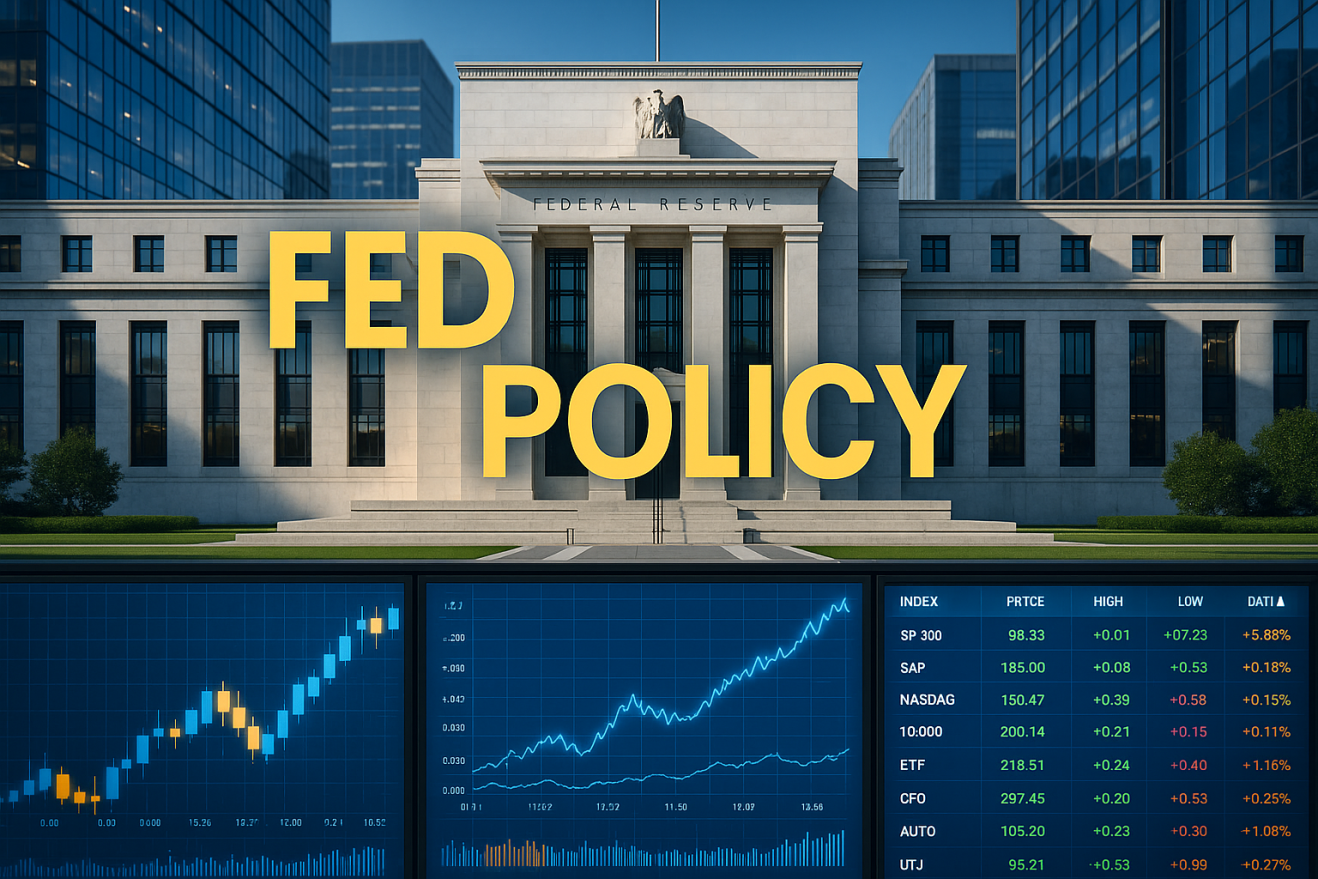Market Anticipation Builds for Powell’s Key Address
Financial markets are holding their collective breath as Federal Reserve Chairman Jerome Powell prepares to deliver his highly anticipated speech at the Jackson Hole Economic Symposium. The address comes at a critical juncture for monetary policy, with investors seeking clarity on the Fed’s approach to persistent inflation pressures and evolving economic conditions.
Market volatility has increased in recent sessions as traders position themselves ahead of Powell’s remarks, which historically have provided significant market-moving insights into Federal Reserve thinking. The speech is expected to address the central bank’s assessment of current economic conditions and provide guidance on future policy direction.
Equity markets have shown mixed performance in recent trading sessions, with the Dow Jones Industrial Average closing down 0.08% at 44,911.82, while the S&P 500 remained relatively flat at 6,449.15. This sideways movement reflects investor uncertainty about the Fed’s next moves and broader economic trajectory.
Inflation Dynamics and Policy Implications
Recent economic data has presented a complex picture of inflationary pressures, with market-based inflation forecasts jumping to levels not seen since April. This resurgence in inflation expectations has complicated the Federal Reserve’s policy calculus and increased the importance of Powell’s upcoming communication.
The persistence of price pressures, particularly in services sectors, has challenged earlier assumptions about the trajectory of inflation toward the Fed’s 2% target. Energy costs, housing expenses, and wage growth continue to contribute to inflationary momentum, despite previous expectations of moderation.
Powell’s speech is expected to address how the Federal Reserve views these inflation dynamics and whether recent data changes the central bank’s assessment of progress toward price stability. Market participants are particularly interested in any signals about the Fed’s tolerance for above-target inflation in the near term.
Interest Rate Policy Crossroads
The Federal Reserve faces a delicate balancing act between maintaining price stability and supporting economic growth. Recent economic indicators have shown resilience in employment markets and consumer spending, but also persistent inflationary pressures that complicate rate policy decisions.
Financial markets have been pricing in various scenarios for future rate movements, with significant uncertainty about the timing and magnitude of potential policy changes. Powell’s speech could provide crucial guidance on the Fed’s reaction function and the conditions that would trigger policy adjustments.
The central bank’s dual mandate of price stability and full employment creates complex trade-offs in the current environment. Economic growth has remained robust, but inflation persistence raises questions about whether additional monetary tightening might be necessary to achieve the Fed’s objectives.
Market Sector Analysis and Performance
Different market sectors have responded variably to the evolving monetary policy environment, with financial stocks generally benefiting from higher interest rate expectations while growth-oriented technology companies face headwinds from tighter financial conditions.
Banking sector performance has been particularly sensitive to interest rate expectations, with higher rates potentially improving net interest margins but also raising concerns about credit quality in a tighter monetary environment. Regional banks have shown mixed performance as investors weigh these competing factors.
Technology stocks, which had driven much of the market’s gains in previous periods, have faced pressure from higher discount rates applied to future earnings. The sector’s performance following Powell’s speech could provide insights into investor sentiment about the sustainability of the current market leadership structure.
Global Economic Context and Coordination
Powell’s speech occurs against the backdrop of coordinated global central bank efforts to address inflation while managing economic growth. The Federal Reserve’s policy decisions have significant international implications, affecting capital flows, currency markets, and global financial stability.
European and Asian central banks have been grappling with similar inflation challenges, though with different economic contexts and policy constraints. The Fed’s approach could influence global monetary policy coordination and affect international economic relationships.
Emerging market economies are particularly sensitive to Federal Reserve policy changes, as shifts in U.S. interest rates affect capital flows and currency stability. Powell’s communication strategy must consider these international spillover effects while focusing on domestic economic conditions.
Corporate Earnings and Economic Fundamentals
The corporate earnings environment provides mixed signals about economic health, with some companies reporting strong performance while others face margin pressures from persistent cost inflation. Powell’s assessment of these economic fundamentals will be closely watched by investors.
Consumer spending patterns have shown resilience despite inflationary pressures, but there are emerging signs of selectivity and trade-down behavior in certain categories. The sustainability of consumer demand represents a crucial factor in the Fed’s economic assessment.
Business investment decisions are increasingly influenced by monetary policy expectations, with companies adjusting capital allocation strategies based on anticipated interest rate environments. Powell’s guidance could significantly impact these corporate planning processes.
Financial Market Infrastructure and Stability
The Federal Reserve’s role in maintaining financial stability adds another dimension to Powell’s policy considerations. Recent market volatility and concerns about asset valuations in certain sectors require careful monitoring and potential policy responses.
Credit markets have shown some signs of tightening, with spreads widening in certain categories and lending standards becoming more stringent. These developments could amplify the effects of monetary policy changes and influence the Fed’s approach to rate adjustments.
The interaction between monetary policy and financial stability considerations has become increasingly complex, requiring sophisticated analysis of potential unintended consequences from policy changes. Powell’s speech may address these interconnections and the Fed’s framework for managing them.
Forward Guidance and Communication Strategy
The Federal Reserve’s communication strategy has evolved significantly in recent years, with greater emphasis on forward guidance and transparency about policy intentions. Powell’s Jackson Hole speech represents a crucial opportunity to refine market expectations and provide clarity about the Fed’s policy framework.
Market participants are particularly interested in any updates to the Fed’s longer-term strategic approach to inflation targeting and employment objectives. Changes in the central bank’s reaction function could have significant implications for asset pricing and economic behavior.
The effectiveness of Fed communication in managing market expectations has become a crucial tool of monetary policy. Powell’s ability to provide clear guidance while maintaining appropriate flexibility will be closely scrutinized by market participants and policy analysts.
Implications for Investment Strategy and Risk Management
Investment managers are adjusting portfolio strategies in anticipation of Powell’s speech and potential policy shifts. The uncertainty surrounding monetary policy direction has increased the importance of risk management and tactical asset allocation decisions.
Fixed income markets are particularly sensitive to Fed communication, with bond yields and yield curve dynamics responding quickly to changes in policy expectations. Powell’s remarks could trigger significant movements in interest rate markets and affect relative value across different maturity segments.
Currency markets are also closely watching for signals about the Fed’s policy trajectory, as interest rate differentials significantly influence exchange rate dynamics. The dollar’s strength or weakness following Powell’s speech could have broad implications for international trade and investment flows.
Conclusion: Navigating Monetary Policy Complexity
Fed Chair Powell’s Jackson Hole speech comes at a pivotal moment for monetary policy and financial markets. The complex interplay of inflation dynamics, economic growth, and financial stability considerations requires sophisticated policy responses and clear communication strategies.
Market participants await guidance that can help navigate the current environment of elevated uncertainty and competing economic pressures. The success of Powell’s communication will be measured by its ability to provide clarity while maintaining the flexibility necessary for effective policy implementation.
As financial markets continue to evolve and adapt to changing economic conditions, the Federal Reserve’s role in providing stability and guidance becomes increasingly crucial. The outcomes of this critical communication moment will influence market behavior and economic decision-making for months to come.
















